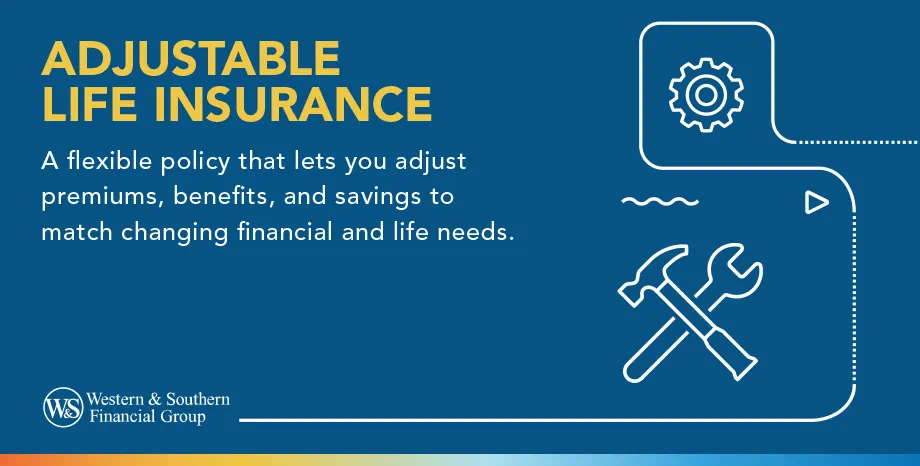

Key Takeaways
- Adjustable life insurance allows you to change parts of your insurance coverage after signing up.
- You can increase or decrease your premium each year, provided you at least cover the minimum insurance cost.
- Most adjustable policies allow you to decrease the death benefit. Some allow you to increase the death benefit, though you may need to go through health underwriting again.
- Adjustable life includes cash value and is permanent coverage that can last your entire life; there's no expiration date.
- These policies are best for those who need planning flexibility, like business owners with uncertain revenue or someone who expects possible changes to their family and financial situation.
When you buy most life insurance products, you typically lock in the coverage details after signing up. That means you likely can't change features such as the premium payment or the death benefit amount. As the name suggests, adjustable (also called universal or flexible premium adjustable) life insurance gives you greater flexibility. Here's some of what to know about adjustable life policies and when they may make the most sense.
Adjustable Life Insurance Defined
Adjustable life insurance, also known as universal life insurance, is a policy that permits you to change coverage details after buying. You can change the premium and the death benefit if you choose.
Adjustable life is a type of permanent life insurance. There's no expiration date. It can last a policyholder's entire life, provided the scheduled premium payments are made.
How Does Adjustable Life Insurance Work?
At first, adjustable life works like other types of life insurance. You pick how much coverage you want for the original death benefit. That "issue amount" as well as your underwriting qualifications (based on gender, age, tobacco usage, health status, etc.) determines the cost of your coverage (i.e., your premium amount). Your insurance contract will describe which factors you can adjust and any restrictions. You can then make these adjustments when needed.
What Factors Can Be Adjusted?
All adjustable life policies allow you to change the premium. You can pay less in some years and more in others. The insurer will tell you the minimum amount you must pay yearly to cover the insurance cost. You must pay at least that much; otherwise, your policy will lapse and your coverage will end.
The insurance cost goes up as you get older. If you pay more than the minimum in a year, the extra money goes into a reserve called cash value. You can use this reserve to cover future premiums.
Many adjustable life policies allow you to reduce the death benefit. Your insurance would then cost less because you would have less coverage. Some policies also allow you to increase the death benefit as well, so you get more coverage in exchange for paying a higher premium. You may need to pay more when first signing up to secure the future option to increase the death benefit, such as by buying a guaranteed insurability rider.
Is Underwriting Required for Changes?
Medical underwriting isn't required to change your premium because this policy is not related to your health. You just need to pay enough to cover the ongoing insurance costs.
You don't need to pass medical underwriting to decrease your death benefit, either. Your policy may also allow you to increase the death benefit by a certain amount without underwriting. For example, the policy may allow you to add $100,000 in additional coverage, but anything above that may require a medical exam.
Does Adjustable Life Have Cash Value?
Yes, adjustable life has a cash value component as an additional life insurance benefit. This is money in the policy you can use while alive. You could withdraw cash value, borrow it through a loan or use it to cover your future premiums. Note that taking out your cash value or using it to cover premium payments will reduce the death benefit for your beneficiaries.
You build cash value by making premium payments. If you pay more than the minimum annual insurance and administrative costs, the extra money goes into your cash value account. You can build cash value more quickly by paying higher premiums each year. If you pay less than the annual insurance cost, your policy will use the cash value (until it runs out) to cover the difference.
You also earn a return on your cash value to grow it for the future. How this works depends on the type of life insurance:
- Adjustable life: A standard adjustable/universal life insurance policy earns interest. Your return depends on market interest rates, which vary over time. While your return changes yearly, you usually receive a guaranteed minimum interest rate.
- Index adjustable life: Performance of an indexed adjustable life insurance policy typically mirrors the performance of a market index, such as the S&P 500. Your growth depends in part on the index performance. However, index adjustable life usually limits your possible gains and losses. For example, it might say that the most your policy could be credited in a good year is 8% interest. In bad years, you may break even, even if the index loses value.
- Variable adjustable life: Variable adjustable life allows you to invest in subaccounts, similar to mutual funds. Your cash value growth depends on your investments. You could see much higher growth if your investments do well compared to the other options. However, you could lose money if the investments perform poorly, possibly forcing you to pay higher premiums to keep your coverage. It's a higher-risk, higher-upside option.
Pros: Benefits of Adjustable Life Insurance
- Payment flexibility: Many life insurance policies charge the same premium the entire time — not adjustable life. This type allows you to change the cost to fit your annual budget.
- Allows coverage changes: Adjustable life could allow you to increase or decrease the death benefit coverage to fit your new needs. You can account for family or financial situation changes without buying new coverage.
- Offers lifelong insurance protection: If you keep up with the ongoing insurance costs, adjustable life lasts your entire life. You ensure your loved ones receive a death benefit payout (versus temporary term life, which eventually expires).
- Builds cash value you can use while alive: You could use your adjustable life cash value as an emergency fund, to save for college expenses, for retirement income or to cover your premiums.
Explore the flexibility of adjustable life insurance to meet your evolving needs. Get a Life Insurance Quote
Cons: Drawbacks of Adjustable Life Insurance
- More expensive than term life: While adjustable life is usually less costly than other permanent life insurance policies, it's still considerably more expensive than term life. Adjustable life policies can charge roughly six to 10 times the premium of a term policy for the same amount of protection.
- Takes extra work to manage: By design, adjustable life policies help you build up cash value in the early years to cover the higher costs later in life. If you underpay, you might risk owing higher premiums or losing coverage in the future. You need to budget more versus a policy that always charges the same amount and won't increase costs later.
- Restrictions to death benefit adjustments: While adjustable life allows some changes to the death benefit, there are usually limits. You might also need to pass health underwriting again to get larger increases to the death benefit.
- Less predictable cash value growth: Your cash value return from adjustable life goes up and down each year. You might end up with less growth than expected due to bad timing, forcing you to pay more in premiums later to compensate for the underperformance.
Steps to Adjust Your Policy
If you own a universal life insurance policy, your life insurance company will have its own system for adjusting the coverage. Expect to follow these general steps:
1. Review Your Adjustable Coverage Rules
Check your original contract to see what changes you can make to the death benefit. Your monthly policy statements should show the minimum payment you need to make to keep your coverage in force without tapping into your cash value. If not, you could request a policy illustration from customer service. This document should also show the minimum required payment. For help understanding this information, contact the financial professional who sold you the policy.
2. Complete a Policy Service Request Form
Insurers typically require you to submit a form to make changes to your policy — it's likely not something you can do online or by phone. You list how much you'd like to change the death benefit. You also list how you'd like to change the premiums and when you'd like the payment change to begin.
Insurers require you to send in a form they review so you don't accidentally create problems for the policy. For example, if you pay less than the annual insurance cost by mistake and risk losing coverage, or if you pay too much into the policy's cash value versus the death benefit, which would turn the policy into a Modified Endowment Contract (MEC). MECs lose the tax benefits for borrowing your cash value while alive.
3. Go Through Underwriting If Necessary
Most adjustable life changes don't require extra underwriting. Underwriting only applies if you want to increase the death benefit and the change is larger what than your contract otherwise allows. If so, you may need to undergo health-related exam and testing protocols again, depending on your insurer.
4. Receive a New Illustration for the Policy Changes
Your insurer will send you a new illustration showing how your changes will impact your death benefit, insurance cost and cash value growth. Update your budget and financial plan as needed.
5. Complete Again for Future Changes
You are free to adjust your universal life policy whenever you want. Simply submit a new form and repeat the process for further changes.
Who Should Consider Adjustable Life?
Now that you know the answer to, "What is adjustable life insurance?" the next question is, "Who should consider these policies?" Adjustable life can be helpful for business owners with revenue that goes up and down. They can overpay during years when business is booming and then scale back during leaner times.
Adjustable life policies could also make sense for someone who might go through life changes requiring a different amount of coverage. These policies could allow them to change the death benefit if needed.
Finally, adjustable life is often best for those with the budget to afford permanent coverage. It is more expensive than term life insurance. In exchange, it offers cash value and coverage that does not expire.
Case Studies of Adjustable/Universal Life Insurance
Case Study 1: Flexible Premiums
Carl owns a fishing charter and tour company. His business earns a lot of money during summer but very little during winter. He buys a flexible premium adjustable life policy that costs $800 a month. Given his cash flow cycle, Carl elects to pay $2,000 per month during the summer and nothing during the winter. Ten years into the policy, Carl's business hits a road bump. He stops paying premiums for a year to focus on turning things around. The following year, his business takes off again. He starts paying higher premiums to make up for the lost time.
Case Study 2: Death Benefit
Susan just had her first child. She bought a $400,000 universal life insurance policy to protect her family. Susan hasn't decided whether she will have more children. She pays extra for a guaranteed insurability rider for the option to add more coverage. Four years later, she does have another child. She uses her adjustable life policy to add another $100,000 in coverage without going through health underwriting.
After her children finish college, Susan recalculates her life insurance coverage needs and decides she can get by with less. She reduces the policy death benefit down to $300,000. This substantially lowers the monthly premium. She keeps more cash value to spend during retirement while maintaining some death benefit as a legacy for her family.
Is An Adjustable Policy Right for You?
This type of life insurance could be right for you if coverage flexibility is your priority. These policies allow you to change your premium and death benefit as your life evolves. In exchange, adjustable life takes a little more work. You need to plan the changes carefully to avoid problems with the policy. For example, you must make sure to cover the ongoing insurance costs so you don't lose coverage in the future.
If you want to keep things simple, a whole life insurance policy charges the same premium the entire time and has more predictable cash flow growth. If you want the lowest-cost option, term life insurance is much more affordable than adjustable life, though the coverage doesn't last your entire life.
Consider speaking with a financial professional to help determine which policy makes the most sense. If you decide adjustable life is the way to go, that person can help you set up the policy and then assist with any requested changes in the future.
Explore how adjustable life insurance can adapt to your changing life needs. Get a Life Insurance Quote
Frequently Asked Questions
What is the difference between adjustable and variable life insurance?
Both adjustable policies and variable life policies let you change the premium and death benefit after signing up. An adjustable life policy earns interest on your cash value, depending on market rates. A variable life policy allows you to invest in subaccounts similar to mutual funds. You can combine both features through a variable universal life (VUL) insurance policy. A VUL offers adjustable premiums and death benefits and lets you invest the cash value in subaccounts.
What is the difference between adjustable and universal life insurance?
There is no difference between adjustable and universal life insurance. They are different names for the same type of coverage. Insurance companies may have different rules for what they offer for these policies, such as whether you can increase the death benefit. However, the terms adjustable life and universal life refer to the same type of protection.
Can you cash out an adjustable policy?
Yes, you can cash out of an adjustable policy. Your policy will show your cash value balance. You can take partial withdrawals from your cash value or cancel the policy to cash out everything at once. You can cash out up to what you paid in premiums without owing taxes. If you cash out your gains, you owe income tax on the withdrawn earnings.


































